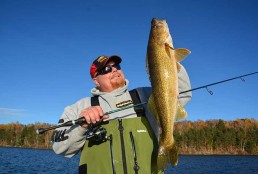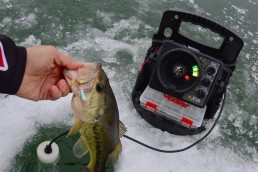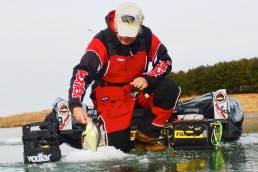October Walleyes Like Ice-fishing Techniques
SHARE THIS POST
It would not exactly be a news flash if I stood up and yelled, “I love ice fishing!” in October, though it may seem odd. What may surprise some would be one of the main reasons why I’m so fond of the sport. Let me put it to you this way: “Hi, my name is Brian Brosdahl, and I am addicted to ‘bites.’” Not just any “bites” mind you, but good, hard bites—the type I get when a fish inhales my lure when I’m standing or sitting directly over the top of them.
The same style of fishing can be used over the side of a boat that anglers use when ice fishing. Both presentations are done directly over the fish, and anglers can use similar finesse-jigging techniques to entice them to bite.
Precise presentations are a big part of fishing through the ice. The subtle things anglers can do to get the fish to bite are much more sophisticated when ice fishing than they are in most open-water situations.
Anglers need to develop closing techniques to finish the deal when a fish gets close to the bait. Many of the same things that work when ice fishing also can work four you when fishing vertically below a boat.
The “Spot-Lock” feature on my Minn Kota is critical for effectively holding over the fish, especially in wind. I need to be able to see my lure on my Humminbird Helix 10 in my boat, just like I need to see the lure on my Helix Ice 5 during the winter.
I also have to be able to keep my lure inside the signal cone of on the sonar to be able to see the lure on my boat graph. I can then fine-tune where I hold my rod tip until I can see the lure. It’s also helpful to use a shorter rod, as some anglers use ice fishing rods out of their boat so they can hold their lures closer to the boat and see their lures on their sonar.
I helped design the Northland Puppet Minnows to fish vertically in open water as well as through the ice. I use the larger PM4 and PM5 for open-water walleyes, while I’ll seldom use anything larger than the PM3 for walleyes during winter.
The colors I use most are their FireTiger, Perch, White or Blue. I’ve seen walleyes that wouldn’t hit anything that didn’t have an orange belly, so sometimes color matters, other times not so much.
Are you enjoying this post?
You can be among the first to get the latest info on where to go, what to use and how to use it!
I prefer to use a heavier rod with a slower action to get the proper jigging motion on the larger Puppet Minnows. My first choice is a 6-foot 3-inch St. Croix Legend rod with medium action. I use 10-pound-test Bionic Braid on the reel with about 5 feet of 8- to 10-pound-test Sunline Fluorocarbon leader and a small snap on the end to connect the lure.
Sometimes I tie the two lines, using either a blood knot or a J-knot. Both work well for connecting fluorocarbon and braided line without a swivel. If I do use a swivel, I’ll shorten the leader and use a tiny number 10 or 12 swivel to minimize the risk of damage in case someone accidentally reels the swivel past the end rod guide.
Jigging spoons can also be used over the side of the boat in fall. I prefer heavier, narrow spoons rather than wider spoons that flutter too much to fish vertically. My favorite spoon is the Northland Sliver Spoon, which is another lure I helped design. It has a slender body and is made with tungsten, so it fishes heavy for its size. I do a short, fast wobble with the Sliver Spoon, which doesn’t give the fish a good look at the spoon and causes it to hit it hard when it bites.
It can be very helpful to put the lure over the side of the boat where you can still see it so you know what your jigging motion looks like to the fish. Experiment with different jigging motions until you find something that looks good with the lure.
Most of the larger lakes in northern Minnesota have good Puppet Minnow bites in the fall. Some of my favorite lakes include Leech and Cass lakes, Winnibigoshish and Lake of the Woods, but my absolute favorite for fishing Puppet Minnows is Devils Lake in North Dakota. Unfortunately, many parts of Devils are extremely bad for snags, so bring plenty of jigs and try not to touch the bottom too much. One of the tricks I’ve learned in lakes that have many opportunities for snags is to snip off the front hook on the Puppet Minnow. Almost all of the fish that bite on these are caught on the back hook or on the small treble hook in the middle.
It is advisable to cast and retrieve jigs like these in lakes with cleaner bottoms. I use a sweeping motion with a lure and try to time the sweep right before the lure strikes the bottom. The Puppet Minnows are deadly on walleyes, but may be even deadlier on deep-water crappies. I downsize the lure size to the PM 2 in most open-water situations for crappies and use 8-pound-test Bionic Braid tipped with a 6-pound-test Sunline fluorocarbon leader.
Brian “Bro” Brosdahl is a nationally known fishing guide and lead spokesman for many of the top companies in ice fishing. He can be contacted at bbro@paulbunyan.net or through his website at brosguideservice.com. Follow him on Instagram, Twitter and Facebook.
MWO
SHARE THIS POST
Did you enjoy this post?
You can be among the first to get the latest info on where to go, what to use and how to use it!
Brian 'Bro' Brosdahl
Outdoor communicator Brian “Bro” Brosdahl lives in northern Minnesota. He is a walleye guide in the Cass Lake, Leech Lake and Lake Winnibigoshish areas. He is sponsored by Northland Fishing Tackle, Frabill/Plano, Aqua-Vu, Humminbird/Minn Kota, St. Croix Rods, Ranger Boats, and Evinrude. Guide inquiries: brosguideservice.com. Follow on social media.



